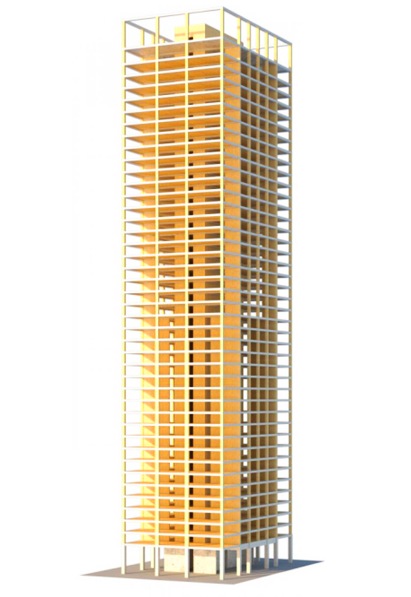In a report released today, Skidmore, Owings & Merrill discussed the results of the Timber Tower Research Project: an examination of whether a viable 400-ft, 42-story building could be created with timber framing. The prototype created by SOM incolves a combination of mass timber, concrete, and steel and was sponsored by the Softwood Lumber Board. Benchmarked against Chicago's DeWitt Chestnut Apartments—a concrete-framed facility considered revolutionary when SOM designed it in 1965—the Timber Tower represents a carbon-footprint reduction of 65% to 75%.
Tall buildings that embody conventional concrete and steel structural design usually have a higher carbon footprint than low-rise buildings, on a square-foot basis. SOM's experiment explores whether tall wood-framed buildings are feasible, justfying changes in contemporary building codes that generally limit the height of such buildings. "Building tall creates desirable urban density, but this solution helps us achieve this result with a much smaller carbon footprint," says SOM Structural and Civil Engineering Partner William F. Baker, PE, Se, FASCE, FIStructE.
SOM staff predict further developments, including possible building code adjustments, based on the research.
(http://archinect.com/news/article/74511379/som-releases-timber-tower-research-project)
Related Stories
| Jan 9, 2012
FGM Architects acquires SRBL Architects
The firm reviewed gaps in each of the markets and identified a need in the municipal market for stronger police facility design expertise as well as additional project management and design expertise for this market.
| Jan 9, 2012
Shawmut appoints Les Hiscoe COO and EVP
In his new role, Hiscoe will focus on developing the Company’s field services divisions; national business in retail, hospitality, gaming, and sports venues; Tri-State business in academic and healthcare; sales and marketing; and human resources
| Jan 9, 2012
Thornton Tomasetti acquires green consulting firm Fore Solutions
International engineering firm launches new building sustainability practice.
| Jan 9, 2012
METALCON International 2012 announced
METALCON 2012 is scheduled for Oct. 9-11 at the Donald E Stephens Convention Center, Hall A, Rosemont, Ill.
| Jan 9, 2012
Lutron appoints Pessina president
In his 35-year career with Lutron, Pessina has acquired broad experience in the engineering, quality assurance and manufacturing areas.
| Jan 9, 2012
A new journey for KSS Architects co-founder
Kehrt's legacy of projects include Rutgers University's Biomedical Engineering Building, the renovation and expansion of Cornell University School of Hotel Administration, the recent new campus center at The Richard Stockton College of New Jersey and Princeton Township's Municipal Complex.
| Jan 8, 2012
TCA releases The Construction of Tilt-Up
The newest publication from the TCA is the second in a planned trilogy of resources covering the architecture, engineering and construction of Tilt-Up
| Jan 8, 2012
WHR Architects promotes Joel Colwell, AIA, to principal
With over 30 years of experience, Colwell has managed large-scale, complex projects for major healthcare systems as well as challenging smaller renovations and additions — all with notable success.
| Jan 6, 2012
Doug Wignall named president of HDR Architecture
HDR Architecture, Inc. is known for its award-winning designs for urban environments, campuses and buildings in the healthcare, science and technology, civic, justice and higher education markets.

















